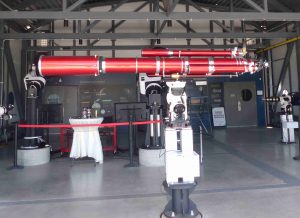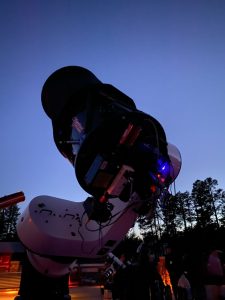Observation night at Lowell
In my last blog, I recounted my visit to Lowell Observatory in Arizona.
After my daytime visit, I returned to Lowell in the evening.

Evening at Lowell Observatory. Phot: Dennis Ashton
Observatory staff run observing evenings for the public.
They have some of the finest telescopes available for public observation.

Giovale Open Deck Observatory. Photo: lowell.edu
The ‘scopes are set out on the Giovale Open Deck Observatory, GODO.
John and Ginger Giovale gave a lead donation for the venture.
Pluto Observatory
On arriving at Lowell I made my way to the Pluto Observatory.
I had missed the morning tour but it was open in the evening.

Pluto Observatory. Photo: Dennis Ashton
The Pluto Observatory houses the telescope with which Clyde Tombaugh discovered Pluto.
The Discovery Telescope is a 13-inch refractor.
It is an astrograph. Instead of an eyepiece it has a wooden case for a photographic plate.

Pluto Astrograph. Photo: Dennis Ashton
Clyde Tombaugh exposed his plates for around an hour.
Then he compared photographs taken a few days apart with a blink comparator.
In February he saw a dot which had moved. It was Pluto.

Pluto Discovery Telescope. Photo: Dennis Ashton
A neat feature of the telescope is a boxing glove to protect an observer as the instrument moves.
Observing Session
I made my way to the observing deck.
It was already open with telescopes prepared for the night’s viewing.

GODO. Photo: Dennis Ashton
The Giovale Open Deck Observatory was opened in 2017.
The opening marked the 125th anniversary of Lowell Observatory.
Moonraker
My favourite telescope was the 8-inch Moonraker.
This sleek F12 refractor was made in England.
It’s metallic burgundy colour was inspired by the paint jobs of Percival Lowell’s cars.

Moonraker Telescope. Photos: Dennis Ashton

Other superb telescopes include a !6-inch Meade Schmidt-Cassegrain and a 32-inch Dobsonian.
I joined the short queues at the eyepieces and observed a range of objects.
The most spectacular were the globular clusters, like M13 and M3.
But the memorable view for me was galaxy M51, the Whirlpool.
In the light-polluted skies of Sheffield, this star city is a mere blur in my telescope.
Here in the clear Arizona sky, I could see awesome detail.
It helped that I was viewing through the massive 32-inch Dobsonian telescope!
Video Images
Some telescopes, like the 14-inch PlaneWave, are linked to monitors.

PlaneWave. Photo: Dennis Ashton
The PlaneWave is fitted with a video camera.
It takes long exposures and displays the image on a screen.
Then observatory astronomers discuss the object on view with visitors.

Image display screens at GODO. Photo: Dennis Ashton

M13 Globular Cluster. Photo: Lowell Observatory

Galaxy at GODO. Photo: Lowell Observatory
Lowell Astronomers
During the evening I talked with several of the astronomers.
One young researcher was involved in finding exoplanets, planets orbiting distant stars.
This is one of the key areas of research at Lowell.
I also spoke with Dr. Amanda Bosh, Chief Operating Officer at Lowell.
Amanda was justifiably proud of the Observing Deck and obviously enjoyed engaging with visitors.
She was kind enough to email me a couple of images from the evening.
Amanda and all the astronomers were very welcoming.
They explained to visitors what they were seeing through the telescopes and on the monitor screens.
The Clark Telescope
At the end of the evening I strolled back to the Clark Telescope.
This was an appropriate place to say farewell to Lowell.
Because this is where it really began.

Clark telescope. Photo: Dennis Ashton
This is the telescope which Percival Lowell used to study Mars.
The observatory that bears his name is synonymous with the discovery of Pluto.

Percival Lowell. Photo: lowell.edu
His observatory continues to be at the cutting edge of astronomical research.
Lowell would be delighted that it is still finding new worlds.
And Lowell Observatory is much more.
It welcomes visitors to soak up its history.
And through their wonderful observing sessions, its dedicated staff allow us to enjoy a glimpse of our universe.
Lowell Observatory is simply one of my favourite places in the universe.
The author: Dennis Ashton is a Fellow of the Royal Astronomical Society and a Wonderdome presenter.
Would you like to hear more Astronomy news?
Do you want to to find out about our upcoming public events?
Follow WonderDome Portable Planetarium on Twitter and Facebook or go to our web site wonderdome.co.uk!

